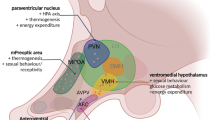Summary
The effects of MSG on PRL cell activity in hamsters was assessed by injecting either MSG (8 mg/g body weight) or saline into male and female hamsters on day 8 of the neonatal period. One-hundred and three days later, the anterior pituitaries were removed for the analysis of PRL synthesis and storage. Serum PRL levels were also determined by radioimmunoassay as an index of in vivo PRL secretion. Blood levels of PRL were decreased by 74% in female and 88% in male hamsters treated with MSG as compared with vehicle controls. In females, glutamate induced a drop in PRL storage (90%) and synthesis (82%) while in male animals glutamate caused a non-significant decrease in PRL storage (48%) and synthesis (31%) as compared with controls. These results indicate that MSG-induced arcuate nucleus lesions inhibit PRL cell activity in the hamster.
Similar content being viewed by others
References
Ben-Jonathan N (1985) Dopamine: a prolactin-inhibiting hormone. Endocr Rev 6: 564–589
Benson B (1987) Temporal changes in medial basal hypothalamic catecholamines in male Syrian hamsters exposed to short photoperiod. Exp Brain Res 65: 371–376
Blask DE, Leadem CA, Orstead KM, Larsen BR (1986) Prolactin cell activity in female and male Syrian hamsters: an apparent sexually dimorphic response to light deprivation and pinealectomy. Neuroendocrinology 42: 15–20
Blask DE, Orstead KM (1986) Dopamine inhibition of prolactin release but not synthesis in the male Syrian hamster: in vitro studies. Life Sci 38: 1915–1921
Burns DM, Leadem CA, Benson B (1986) The presence of biologically active dopamine receptors in the pituitaries of long and short photoperiod-exposed male hamsters. Proc 1st Int Congr Neuroendocrinology, Abstr 222, p 80
Burns DM, Leadem CA, Benson B (1987) Alteration in pituitary sensitivity to dopamine is not a mechanism in short photoperiod-induced prolactin inhibition. Biol Reprod 36 [Suppl 1]: 149
Clemens JA, Roush ME, Fuller RW, Shaar CJ (1978) Changes in luteinizing hormone and prolactin control mechanisms produced by glutamate lesions of the arcuate nucleus. Endocrinology 103: 1304–1312
Dada MO, Blake CA (1984) Administration of monosodium glutamate to neonatal male rats: alterations in the gonadotrophs and in gonadotrophin secretion. Neuroendocrinology 38: 490–497
Inoue T (1989) Modulation of pituitary prolactin secretion in rats treated neonatally with monosodium glutamate (MSG). 71st Ann Mtg Endocr Soc, Abstr 812, p 225
Lamperti A, Blaha G (1976) The effects of neonatally-administered monosodium glutamate on the reproductive system of adult hamsters. Biol Reprod 14: 362–369
Lamperti A, Blaha G (1980) Further observations on the effects of neonatally administered monosodium glutamate on the reproductive axis of hamsters. Biol Reprod 22: 687–693
Lamperti A, Pupa L, Tafelski T (1980) Time-related effects of monosodium glutamate on the reproductive neuroendocrine axis of the hamster. Endocrinology 106: 553–558
Massa JM, Blask DE (1989) An early pineal-induced suppression of pituitary prolactin mRNA levels in light-deprived male hamsters. Neuroendocrinology 50: 506–512
Nemeroff CB, Konkol RJ, Bissette G, Youngblood W, Martin JB, Brazeau P, Rone MS, Prange AJ, Breese G, Kizer JS (1977) Analysis of the disruption in hypothalamicpituitary regulation in rats treated neonatally with monosodium-L-glutamate (MSG): evidence for the involvement of tuberoinfundibular cholinergic and dopaminergic systems in neuroendocrine regulation. Endocrinology 101: 613–622
Olney JW (1980) Excitotoxic mechanisms of neurotoxicity. In: Spencer PS, Schaumburg HH (eds) Experimental and clinical neurotoxicity. Williams and Wilkins, Baltimore, pp 272–294
Orstead KM, Blask DE (1985) Presence of prolactin (PRL) synthesis-inhibitory activity in the hamster stalk-median eminence: effects of blinding and pinealectomy. In: MacLeod RM, Scapagnini U, Thorner MO (eds) Prolactin-basic and clinical correlates. Liviana Press, Padova, pp 112–121
Orstead KM, Blask DE (1987) Neuroendocrine effects of light deprivation and pinealectomy in vivo on the time course of changes in prolactin cell activity in vitro. Neuroendocrinology 45: 182–190
Orstead KM, Blask DE (1987) Evidence for dopamine receptor-mediated inhibition of prolactin cell function in the female Syrian hamster. Endocr Res 13: 143–156
Pickard GE, Turek FW, Lamperti AA, Silverman AJ (1982) The effect of neonatally administered monosodium glutamate (MSG) on the development of retinofugal projections and the entrainment of circadian locomotor activity. Behav Neural Biol 34: 433–444
Reiter RJ, Ferguson BN (1979) Delayed reproductive regression in male hamsters bearing intrarenal pituitary homografts and kept under natural winter photoperiods. J Exp Zool 209: 175–180
Soares MJ, Colosi P, Talamantes F (1983) Development of a homologous radioimmunoassay for secreted hamster prolactin. Proc Soc Exp Biol Med 172: 379–381
Author information
Authors and Affiliations
Rights and permissions
About this article
Cite this article
Blask, D.E., Leadem, C.A. & Pelletier, D.B. Influence of neonatally-administered monosodium glutamate on the neuroendocrine regulation of prolactin cell activity in adult Syrian hamsters. J. Neural Transmission 82, 1–9 (1990). https://doi.org/10.1007/BF01244830
Received:
Accepted:
Issue Date:
DOI: https://doi.org/10.1007/BF01244830




